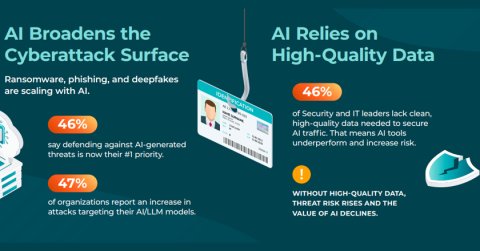
Gigamon, a leader in deep observability, recently released its 2025 Hybrid Cloud Security Survey, revealing that hybrid cloud infrastructure is under mounting strain from the growing influence of artificial intelligence (AI).
The annual study, now in its third year, surveyed over 1,000 global Security and IT leaders across the globe. As cyberthreats increase in both scale and sophistication, breach rates have surged to 55 percent during the past year, representing a 17 percent year-on-year (YoY) rise, with AI-generated attacks emerging as a key driver of this growth.
Security and IT teams are being pushed to a breaking point, with the economic cost of cybercrime now estimated at $3 trillion worldwide according to the World Economic Forum. As AI-enabled adversaries grow more agile, organisations are challenged with ineffective and inefficient tools, fragmented cloud environments, and limited intelligence.
Key Findings Highlight How AI Is Reshaping Hybrid Cloud Security Priorities
- AI’s role in escalating network complexity and accelerating risk is evident. The study reveals that 46 percent of Security and IT leaders say managing AI-generated threats is now their top security priority. One in three organisations report that network data volumes have more than doubled in the past two years due to AI workloads, while nearly half of all respondents (47 percent) are seeing a rise in attacks targeting their organisation’s large language model (LLM) deployments. More than half (58 percent) say they’ve seen a surge in AI-powered ransomware—up from 41 percent in 2024 underscoring how adversaries are exploiting AI to outpace and outflank existing defences.
- Compromises highlight continued trade-offs in foundational areas of hybrid cloud security nine out of ten (91 percent) Security and IT leaders concede to making compromises in securing and managing their hybrid cloud infrastructure. The key challenges that create these compromises include the lack of clean, high-quality data to support secure AI workload deployment (46 percent) and lack of comprehensive insight and visibility across their environments, including lateral movement in East-West traffic (47 percent).
- Public cloud risks prompt industry recalibration. Once considered an acceptable risk in the rush to scale post-COVID operations, the public cloud is now coming under increasingly intense scrutiny. Many organizations are rethinking their cloud strategies in the face of their growing exposure, with 70 percent of Security and IT leaders now viewing the public cloud as a greater risk than any other environment. As a result, 70 percent report their organization is actively considering repatriating data from public to private cloud due to security concerns and 54 percent are reluctant to use AI in public cloud environments, citing fears around intellectual property protection.
- Visibility is top of mind for Security leaders. As cyberattacks become more sophisticated, the limitations of existing security tools are coming sharply into focus. Organisations are shifting their priorities toward gaining complete visibility into their environments, a capability now seen as crucial for effective threat detection and response. More than half (55 percent) of respondents lack confidence in their current tools’ ability to detect breaches, citing limited visibility as the core issue. As a result, 64 percent say their number one focus for the next 12 months is achieving real-time threat monitoring delivered through having complete visibility into all data in motion.
Deep Observability Becomes the New Standard
With AI driving unprecedented traffic volumes, risk, and complexity, nearly nine in 10 (89 percent) Security and IT leaders cite deep observability as fundamental to securing and managing hybrid cloud infrastructure. Executive leadership is taking notice, as boards increasingly prioritise complete visibility into all data in motion, with 83 percent confirming that deep observability is now being discussed at the board level to better protect hybrid cloud environments.
“Security teams are struggling to keep pace with the speed of AI adoption and the growing complexity and vulnerability of public cloud environments”, said Mark Jow, technical evangelist, EMEA, at Gigamon. “Deep observability addresses this challenge by combining MELT data with network-derived telemetry such as packets, flows, and metadata, delivering increased visibility and amore informed view of risk. It enables teams to eliminate visibility gaps, regain control, and act proactively with increased confidence. With 88 percent of Security and IT leaders agreeing it is critical to securing AI deployments, deep observability is fast becoming a strategic imperative”.
“With nearly half of organisations saying attackers are already targeting their large language models, AI security can’t be an afterthought, it needs to be a top priority”, said Mark Walmsley, CISO at Freshfields. “The key to staying ahead? Visibility. When we can clearly see what’s happening across AI systems and data flows, we can cut through the noise and manage risk more effectively. Deep observability helps us spot vulnerabilities early and put the right protections in place before issues arise”.
Image Credit: Gigamon





